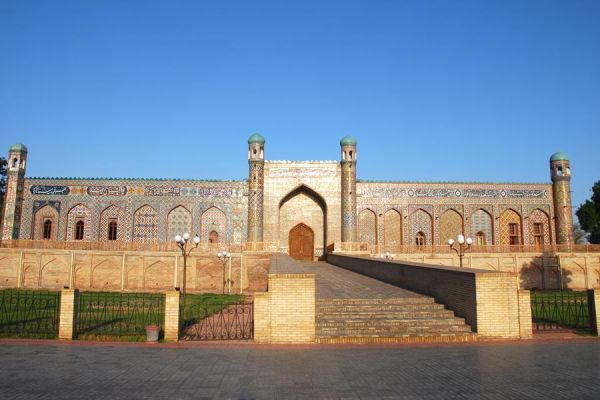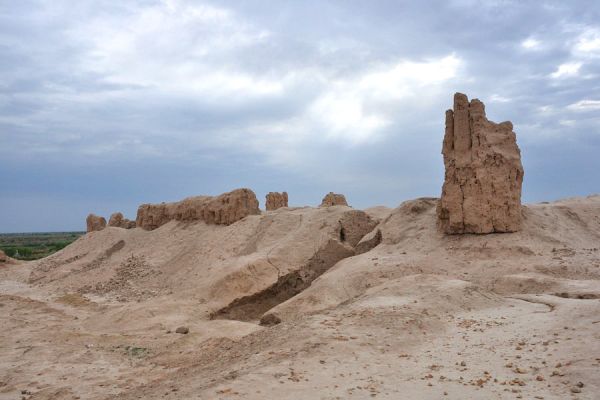Khudoyar Khan's Palace (Kokand Urda)
One of the main attractions of Kokand is the Kokand citadel – "Urda", better known as the palace of Khudoyar Khan. It is known from historical chronicles that for a century and a half, 29 khans replaced the Kokand throne, but the most famous of them was the last, Khudoyar Khan. He ascended the throne in 1845, at the age of twelve, becoming the son-in-law of the all-powerful local military commander Mingbashi Musulmonkul. In the thirty years of his reign, he lost power four times in the struggle with his relatives, and each time he regained it.
The palace of Khudoyar Khan, built in 1871, was the seventh khan's palace in a row and was supposed to surpass all previous ones in size and splendor, asserting the power of the Kokand ruler. Indeed, the building covered an area of 4 hectares, was 138 meters long and 65 meters wide. The palace was raised on a three-meter platform, and a ramp led to the main entrance, at the foot of which once stood cast-iron and copper cannons. On the portal, between the guldasta towers that framed it, above the huge carved doors, there is an inscription in Arabic made of carved majolica: "The Great Said Muhammad Khudoyar Khan." The palace was surrounded by a beautifully carved fence. On the right flank, a faceted minaret was built, lined with ceramic tiles imitating the colors of Ferghana silk beads.
The construction of this magnificent palace complex, consisting of seven small courtyards surrounded by buildings, was led by the architect Mir Ubaidullo. The best craftsmen from different cities of the Ferghana Valley participated in the finishing work, and the ceramic tiles for the facade were made by artisans from Rishtan, the ancient center of ceramics. In total, the palace had 119 rooms decorated with openwork ganch carvings, ornamental paintings in tempera paints and gilded cornices cast from alabaster. The throne room and reception area were the most elegant, as well as the treasury, treasury and arsenal. There was a special hall where the khan tried his subjects. In addition, the palace had the private chambers of Khodyar Khan and his four wives. The ornate rooms were also reserved for his four sons and two daughters. There was a harem in one of the courtyards, where forty concubines were kept. The small rooms were inhabited by numerous servants who served the palace.
In 1865, Russia annexed Tashkent, the former Kokand domain, to its territories. However, at that time, the khan's relations with his Fergana subjects were not developing in the best way. Military leaders and soldiers were no longer paid salaries, and the harsh treatment of dehkans and townspeople gave rise to constant unrest and riots, which were suppressed with particular brutality. 1875 was the last year of Khudoyar Khan's rule, and he was forced to flee and seek asylum in Russia. Soon, Russian troops, without encountering serious resistance, took Kokand, and in 1876, Russia annexed the Kokand Khanate.
Khudoyar Khan, accompanied by an escort of Ural Cossacks, along with his court officials, wives and harem headed for Tashkent. In addition, thirty boxes of gold and jewelry from the khan's treasury were loaded onto pack horses. However, when the caravan arrived at the residence of the Russian governor-General of the Turkestan region and the khan handed him the state seal of the Kokand Khanate, only a small fraction of the treasures remained. There were various rumors: either the Cossacks plundered Khudoyar Khan's gold, or the khan himself secretly sent his fortune to Afghanistan, where, after long wanderings in foreign lands, he settled in a small village, squandered the treasures and died in poverty. Anyway, nowadays several large museums have unique exhibits from Kokand Urda. So, in St. Petersburg, the Hermitage houses the throne of Khudoyar Khan, decorated with precious stones.
Over the years, the interior layout of the former Khan's palace has undergone significant changes. Only two courtyards and 19 rooms remain of the former splendor, which houses the city Museum of Local lore, which has many unique exhibits in its collection that tell about the rich historical past of Kokand. And the amazing ornaments adorning the palace facade amaze with the variety and sophistication of the color combinations and speak to the unfading glory of the ceramics masters of the Fergana Valley.





















